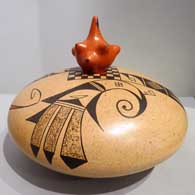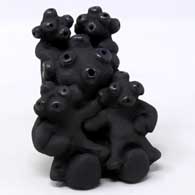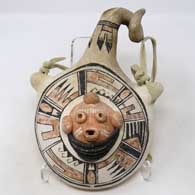Mudheads
Most Pueblos
Hopi

Santa Clara

Laguna
The Mudhead Clown (Koyemsi) symbolizes some of the results of a limited gene pool. Among the Hopi (who name them Tatsuki or Koyemsi or Tatsiqto) and Zuni (who name them Koyemshi) they are usually portrayed with a black dress, pinkish clay-coated bodies and a matching cotton bag worn over the head. Koyemsi Mana (Mudhead Maiden) is one of the Hopi katsinas. The Anglicized Mudhead Clown derives the mudhead appearance from the Koyemsi mask with its loosely formed mud balls looking vaguely like human features.
Zuni origin legends say the first Koyemsi fathered nine children with his sister. In remorse for that act he beat himself up and then rolled in the mud until the bulbous welts on his head were covered with mud. When the children were born, they resembled this mud version of their father with faces and bodies distorted with various muddy protruberances. Because of that incestuous conception, they are prevented from becoming kachinas themselves and instead act in secondary roles, often as a spokesperson for another kachina. Neither a ceremonial dancer nor a priest, the Mudhead Clown often participates in social gatherings as a curer, warrior, director, sage, trickster, messenger or any combination of these.
(505) 986-1234 - www.andreafisherpottery.com - All Rights Reserved
